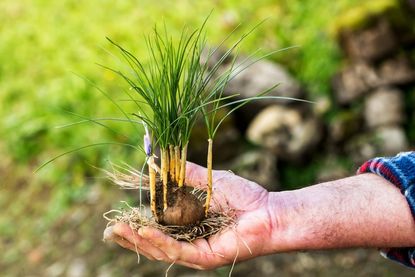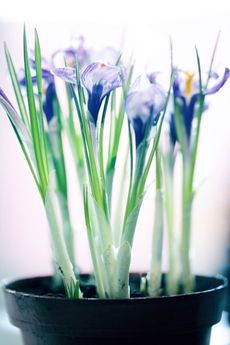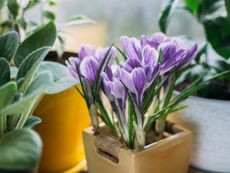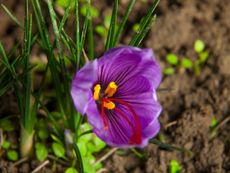Non Blooming Saffron Crocus - How To Get Saffron Crocus Flowers


Saffron is obtained from harvesting the styles off mature Crocus sativus flowers. These tiny strands are the source of an expensive spice useful in many global cuisines. If you find your saffron not flowering, you may be stuck buying the spice at premium prices at the supermarket. In order to enjoy the beauty of the flowers and, more importantly, protect your pocketbook, finding out why saffron crocus is not blooming is crucial. Read on to find out how to get saffron crocus flowers in full production.
Saffron Crocus Growing Conditions
Saffron has been a popular spice since ancient times. It has an important place in the cuisines of Africa, the Middle East, and Mediterranean cuisines, and was a common barter spice brought to new lands by Spanish and other explorers. The spice is pricey but you can grow your own and harvest the flavor and color rich styles from the centers of your flowers. That is, of course, if you have the proper saffron crocus growing conditions. Who ever heard of a non-blooming saffron crocus anyway? What would be the point? In fact, some bulbs may be non-blooming due to disease, insect interference or damage to the embryo. The first step to correcting the issue is to dig up and examine the bulbs. Only plant back the healthiest that are without blemish and are plump, smooth and about 4 inches (10 cm.) in diameter. Make sure your soil is well draining and the location is in full sun. Plant the bulbs 5 to 6 inches (12.5 to 15 cm.) deep in fluffy but gritty loam. Add a bit of potassium rich fertilizer directly into the planting hole or cover the soil over the bulb with wood ash. Avoid nitrogen fertilizers which force more greenery at the expense of the flowers. Keep in mind that the hardiness range of saffron is United States Department of Agriculture zones 5 to 8. In other zones, the bulbs may refuse to flower.
How to Get Saffron Crocus Flowers
Even the experts admit the bulbs aren't easy to bring to flower. The extra potassium should help but if you plant at the wrong time, these fall bloomers may refuse to produce flowers. Early August is a perfect time to install the bulbs. Understanding the life cycle of these pretty little flowers might prove useful. The leaves erupt in late winter to early spring. No blooms occur during this time. Once the temperatures start to heat up, the bulb goes dormant and the leaves die back. During this time, water the bulbs sparingly. New leaves form in September when cooler air arrives. Once you have leaves, the flower makes its appearance. If the saffron crocus is not blooming, it might have gotten hit with an early freeze or site and soil conditions may not be right.
Non-Blooming Saffron Crocus Triage
Generally, saffron crocus flower well the first year but slowly peter out over successive years. Old bulbs could be the reason for saffron not flowering. The good news is that the bulbs will naturalize and you can dig up and separate the biggest, most vigorous ones to grow. Another common cause of failure to bloom in saffron is from pests and not the little brother type pest. I am referring to rodents and birds. Rodents will eat the bulb and birds will pluck off the flowers. Use bait stations to keep rodents at bay and bird netting to protect the blooms. Once you have a lovely crop of fall crocus, use tweezers to harvest the red styles. Dry them and store them in a dim, cool location until ready to use in Paella or whatever your favorite saffron dish may be.
Gardening tips, videos, info and more delivered right to your inbox!
Sign up for the Gardening Know How newsletter today and receive a free download of our most popular eBook "How to Grow Delicious Tomatoes."

Bonnie Grant is a professional landscaper with a Certification in Urban Gardening. She has been gardening and writing for 15 years. A former professional chef, she has a passion for edible landscaping.
-
 Want a Backyard Mini Orchard? Create Your Own Container Orchard
Want a Backyard Mini Orchard? Create Your Own Container OrchardEasier to care for in small spaces, a backyard mini-orchard makes sense for busy gardeners and juicy fruit is the reward.
By Teo Spengler
-
 Urban Beekeeping Guide: Top Tips For Raising Bees In The City
Urban Beekeeping Guide: Top Tips For Raising Bees In The CityUrban beekeeping can be a rewarding and appreciated pastime, but first be sure it’s legal in your city and learn the ropes of beekeeping.
By Mary Ellen Ellis
-
 Growing Saffron Indoors: Care Of Saffron Crocus In The Home
Growing Saffron Indoors: Care Of Saffron Crocus In The HomeThe care of saffron crocus is no more difficult than that of any other type of bulb. In fact, it can even be grown indoors. Container-grown saffron is easy. Read this article to learn about their indoor care.
By Amy Grant
-
 Saffron Harvest Info: How And When To Pick Saffron
Saffron Harvest Info: How And When To Pick SaffronThere's more to saffron than just growing it. You need to know how and when to harvest the herb. Learn about saffron crocus harvesting and its uses today by reading this article.
By Amy Grant
-
 Container Grown Saffron - Care Of Saffron Crocus Bulb In Containers
Container Grown Saffron - Care Of Saffron Crocus Bulb In ContainersSaffron is an ancient spice that has been used as a flavor for food and also as a dye. Saffron comes from the three stigmas of the fall blooming Crocus sativus plant. Learn how to grow these plants in pots in this article.
By Susan Patterson
-
 Information On How To Grow Saffron Crocus Bulbs
Information On How To Grow Saffron Crocus BulbsSaffron has been described as a spice that is worth more than its weight in gold. It is so expensive that you may wonder a??Can I grow saffron crocus bulbs and harvest my own saffron?a?? Read here to find out.
By Heather Rhoades